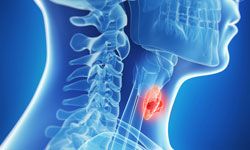Low-Dose Radiation As Effective as Standard Dose for Select Patients With Thyroid Cancer
Patients with thyroid cancer classified as having low risk of disease recurrence can be treated safely with a lower dose of radiation following surgery, compared with the standard higher dose, according to long-term findings from the HiLo trial presented at the National Cancer Research Institute (NCRI) Cancer Conference.

Patients with thyroid cancer classified as having low risk of disease recurrence can be treated safely with a lower dose of radiation following surgery, compared with the standard higher dose, according to long-term findings from the HiLo trial presented at the National Cancer Research Institute (NCRI) Cancer Conference.1
Additionally, results from the study showed there was no significant difference in the recurrence rate between patients who were prepared for ablation using Thyrogen (thyrotropin alfa for injection) or thyroid hormone withdrawal (THW).
Based on these findings, lead study author Jonathan Wadsley, MD, said international guidelines should be updated to recommend lower-dose radiation for low-risk patients.
"Now that we have confirmation that there is no difference in recurrence rates over a longer follow-up period, these recommendations can be strengthened and clinicians and patients can be confident that use of the lower activity is acceptable, and in fact, preferable," said Wadsley, ,a consultant clinical oncologist at the Weston Park Hospital, Sheffield, UK, and chair of the NCRI Thyroid Cancer Subgroup, in a news release.2
Between 2007 and 2010, a total of 434 patients with low-risk thyroid cancer were randomized to receive either low administered radioactive iodine activity (RAI) of 1.1GBq or the standard high RAI of 3.7GBq. Patients were prepared for ablation with either Thyrogen, a genetically-engineered thyroid-stimulating hormone (TSH), allowing for thyroid cancer cells to absorb as much radioactive iodine as possible, thereby making the treatment more effective or THW, which required patients to stop taking their thyroid hormone tablets, allowing levels of their natural TSH to rise.
At a median follow-up of 6.5 years, a total of 21 patients had disease recurrence 11 patients who received 1.1GBq and 10 patients who received 3.7GBq. The recurrence rates at 3, 5, and 7 years were similar between patients who received 1.1GBq RAI (1.5%, 2.1%, and 5.9%, respectively), and 3.7GBq RAI (2.1%, 2.7%, and 7.3%, respectively); (HR, 1.10; 95% CI, 0.47-2.59; P= .83). Patients who received Thyrogen had recurrence rates of 1.5%, 2.1%, and 8.3% at 3, 5, and 7 years, respectively. Patients who had THW had recurrence rates of 2.1%, 2.7%, and 5.0% at 3, 5, and 7 years, respectively (HR, 1.62; 95% CI, 0.67-3.91;P= .28).
Investigators noted that patients who had T- and N-stage disease, as well as T3 patients, did not have noticeably more recurrences with the 1.1GBq dose compared with the 3.7GBq dose. However, 1 patient with T3-stage disease and N0 at baseline, who received a dose of 1.1GBq, died from their disease.
"The study showed that patients receiving a lower activity experienced fewer side effects, in particular less risk of feeling sick or suffering damage to the salivary glands, which can potentially lead to a permanently dry mouth. The use of a lower activity also raises the possibility of giving the treatment in 1 day rather than having to admit patients to be nursed in isolation for 2 to 3 nights,” Wadsley said. “This is required for the higher activity due to radiation protection regulations to avoid exposing the general public to unnecessary radiation, but can be particularly distressing for patients as they can only have very limited contact with other people during this time, which is particularly hard for someone with a recent cancer diagnosis. Therefore, not only is lower activity preferable for patients, it can also result in cost savings to the health service," Wadsley added.
In the ongoing IoN trial (NCT01398085), investigators are now exploring whether select patients can forego radioiodine therapy completely. The study is currently enrolling patients with thyroid cancer who have very low risk of recurrence to receive either radioiodine therapy or observation alone. The trial aims to investigate whether there is a difference in recurrence rates between the 2 groups.
References:
- >Wadsley J, Khaled S, Dehbi H M, Mallick U, et al. Recurrence rates after low-dose radioiodine ablation for differentiated thyroid cancer within the NCRI HiLo trial. Presented at: 2018 NCRI Cancer Conference; November 4-6, 2018; Glasgow, UK. LBA 2148.http://abstracts.ncri.org.uk/abstract/recurrence-rates-after-low-dose-radioiodine-ablation-for-differentiated-thyroid-cancer-within-the-ncri-hilo-trial/
- Patients with low risk thyroid cancer can receive lower doses of radiation treatment. Published online November 4, 2018. Accessed November 25, 2018. https://www.eurekalert.org/pub_releases/2018-11/ncri-pwl110118.php.
Anticipating Novel Options for the RAI-Refractory DTC Armamentarium
May 15th 2023In season 4, episode 6 of Targeted Talks, Warren Swegal, MD, takes a multidisciplinary look at the RAI-refractory differentiated thyroid cancer treatment landscape, including the research behind 2 promising systemic therapy options.
Listen
No Improvement With Durvalumab vs Cetuximab in Advanced HNSCC
January 9th 2025The NRG-HN004 trial showed that durvalumab did not improve outcomes vs cetuximab in locoregionally advanced head and neck squamous cell carcinoma undergoing radiotherapy with contraindications to cisplatin, leading to early trial closure.
Read More